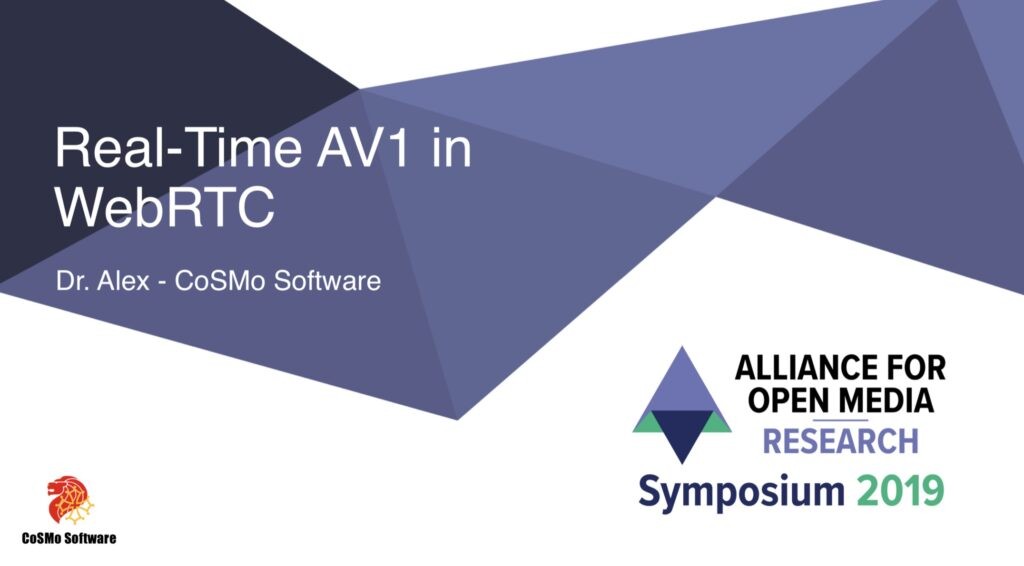WebRTC continues to live two lives; one of massive daily use in video conferencing in apps from Google, Facebook as well as many others, and one as a side-lined streaming protocol in hte broadcast and streaming industry. WebRTC is now an IETF/W3C standard, is a decade old and is seeing continued work and innovation from Google, other large companies and smaller specialists pushing it forward.
In this extended Streaming Media Connect video with Millicast’s Ryan Jespersen, we explore where WebRTC is up to now, how it can replace RTMP, how real-time AV1 not only shows the innovation within the technology but also enables several use cases and upcoming technologies such as end-to-end encryption for streaming workflows. The video is in sections: product demos, technology discussion and overviews of use cases.
A clear first question is why bother with WebRTC at all. Ryan’s quick to point out that WebRTC is in daily use not only in many of the big video call apps but also in Clubhouse, the high-scale WebRTC-based interactive audio platform. He also establishes that it’s commonly in use on CDNs such as Limelight and Millicast to deliver ultra-low-latency streams to end-users for auctions, gambling and interactive streams, but also as part of broadcast workflows. NFL, for instance, used WebRTC for low-latency monitoring of 122 cameras for the Super Bowl. As far as end-users are concerned, Ryan sees the ‘interactivity’ market as a way, as yet untapped, to release value in many verticals and will be the fastest-growing sector of the streaming industry over the next few years.
Looking back at Flash, Ryan explains that we came from a point where we had a low-latency protocol in the name of RTMP. Its latency was in the realms of 1 to 3 seconds, it had end-to-end security, encoder control and interactivity. RTMP was displaced due to three main factors, security concerns, rejection of the proprietary nature of the protocol and the move to HLS which provided improved scalability and was enthusiastically adopted by CDNs.
WebRTC, Ryan contends, learns from the mistakes of RTMP. WebRTC has ways to recover lost packets, is content agnostic, has a solution for NAT traversal, is non-proprietary and has no plugins. These latter two points address many of the security concerns of RTMP. Now a standard, the W3C has documented many upcoming use cases for this free, Open Source, technology.
Why, then, do we not see WebRTC much more prevalent in video streaming such as Netflix or Peacock? This is a question that Russell Trafford-Jones discussed in this IBC panel with nanocosmos, M2A and VisualOn. One view from that panel is that sub-second is lower than needed for some services. For instance, a public broadcaster may not wish to deliver online faster than it does over the air. Also, there’s a quality issue to contend with. One strength of WebRTC is that it prioritises latency over quality, always. This is great for face-to-face communication, but tier-1 broadcasters want people to see video in the same quality that left their encoders and if that means waiting for packets to be recovered instead of showing an impaired signal, that’s what they will do. As ever, therefore, this is a business decision that has to pay careful attention to the needs of the viewers, the quality aspirations of the viewers and broadcaster/provider as well as the technical pros and cons of each approach.

Ryan tlks about Real-time AV1 in WebRTC covered also in this talk
Moving on to AV1, Ryan explains that this royalty-free codec has been sped up significantly since the early days when it required thousands of CPUs for real-time encoding. Using AV1 is a boon for WebRTC for two reasons: screen content and scalable video coding. Screen Content Coding is a set of techniques to adapt encoding specifically for screen content meaning computer graphics whether that be in games or just sending a computer desktop. With straighter lines and the possibility for many parts of the screen to be identical or close to identical to other parts, it’s possible to get much better encoding for screen content if you can detect it and optimise for it.
Ryan moves on to AV1’s use in shoring up security. Although a codec and not a security measure in and of itself, AV1’s ability to send multiple resolutions in one stream is a big deal for securing communications. Scalable video coding, SVC, is not a new technology, but AV1 is one of the first mainstream, modern codecs which has it by default. This enables an encoder to encode to, say, sub-SD, SD and HD resolution and send these all at once in one stream. These are not simply 3 encodes squeezed down the same pipe, but they encode that build on top of each other. The sub-HD provides a foundation on which the SD feed provides enhancement information. You need both the sub-SD and SD layer to get SD. Adding on the HD layer to those two gives you that full-resolution HD. By only delivering the extra information needed for HD rather than all the underlying data again, a lot of bitrate can be saved. Importantly, by generating all the encoding at the source, you can encrypt at the source for an end-to-end encrypted workflow and also deliver multiple bitrates. Ryan explains that the move to ABR streaming, whether HLS, DASH or otherwise breaks the end-to-end security model as the need to transcode the media necessitates being able to view it. Using AV1’s SVC is one way around the need for mid-workflow transcoding.
One aspect is missing, though, for modern streaming workflows. If you don’t want to do peer-to-peer networking, some form of traffic manipulation will be needed in your CDN and/or delivery infrastructure. This is why Ryan says that Millicast has proposed that ‘secure frames’ are added to the WebRTC spec. Whilst this talk doesn’t detail their functionality they add a way of encrypting data twice such that the media can be encrypted for end-to-end workflows, but also each hop can be separately encrypted. This provides just enough access to the metadata of the stream for traffic manipulation, but without allowing access to the underlying media.
As the video comes to end, Ryan gives us a glimpse into one other upcoming technology that may be added to WebRTC called WHIP. The RFC explains the intention of WHIP:
The WebRTC-HTTP ingest protocol (WHIP) uses an HTTP POST request to perform a single shot SDP offer/answer so an ICE/DTLS session can be established between the encoder/media producer and the broadcasting ingestion endpoint. Once the ICE/DTLS session is set up, the media will flow unidirectionally from the encoder/media producer broadcasting ingestion endpoint. In order to reduce complexity, no SDP renegotiation is supported, so no tracks or streams can be added or removed once the initial SDP O/A over HTTP is completed.
Ryan closes his video with a demonstration of the Millicast platform and looks at how other use cases might be architected such as watch parties.
Watch now!
Download the slide deck
Speaker
 |
Ryan Jespersen Head of Sales and Marketing Millicast |

